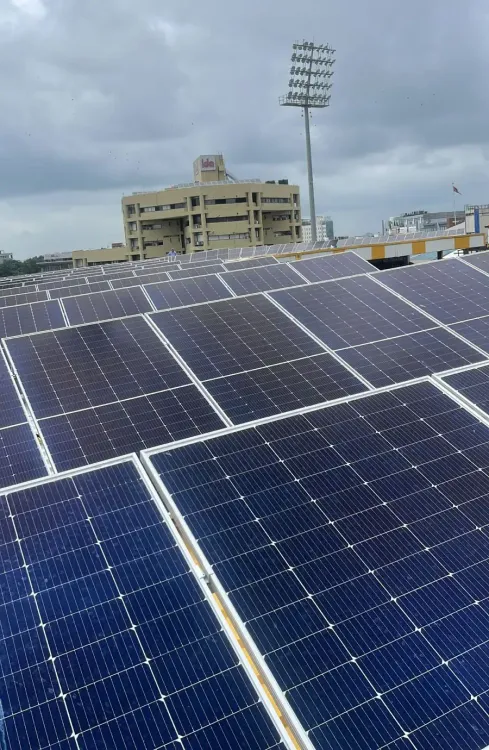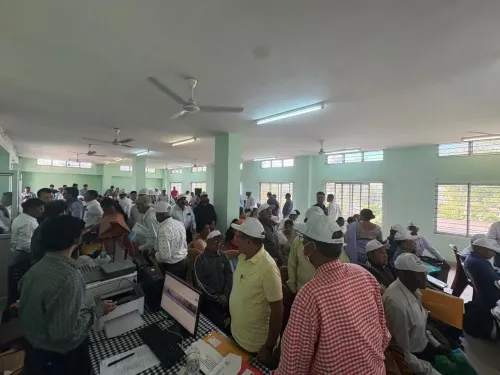Is India Set to Become the Second-Largest Renewables Growth Market Globally?

Synopsis
Key Takeaways
- India is on track to become the second-largest renewables growth market globally.
- The IEA forecasts a global increase of 4,600 GW in renewable power capacity by 2030.
- Solar PV is set to drive around 80% of the global increase in renewable capacity.
- Supply chain security remains a concern, heavily concentrated in China.
- Investment in grid integration and storage is urgently needed.
New Delhi, Oct 7 (NationPress) The growth of renewable energy sources for electricity generation is gaining substantial momentum globally, positioning India to emerge as the second-largest market for renewable growth worldwide, trailing only behind China. According to the IEA's medium-term forecast released on Tuesday, India is well on track to achieve its ambitious goals by 2030.
The surge in solar photovoltaic (PV) technology is a primary driver behind this expansion, occurring amidst challenges related to supply chains, grid integration, financial constraints, and policy changes. Overall, the renewable sector is anticipated to more than double in size by 2030.
The IEA's main annual report, titled “Renewables 2025,” forecasts a global increase in renewable power capacity by 4,600 gigawatts (GW) by 2030, equivalent to adding the entire power generation capacity of China, the European Union, and Japan combined.
Solar PV is expected to contribute approximately 80 percent of this global capacity increase over the next five years, thanks to its low costs and quicker permitting processes, followed by wind, hydro, bioenergy, and geothermal sources.
Geothermal installations are projected to reach unprecedented levels in key markets such as the US, Japan, and Indonesia, along with numerous emerging economies.
Challenges related to grid integration are rekindling interest in pumped-storage hydropower, with its growth projected to advance nearly 80 percent faster over the next five years compared to the previous period.
In developing regions across Asia, the Middle East, and Africa, the combination of cost competitiveness and enhanced policy support is propelling a faster adoption of renewable energy, with numerous governments launching new auction initiatives and increasing their targets.
On a corporate level, confidence in renewable initiatives remains robust. The majority of leading developers have either maintained or elevated their deployment targets for 2030 compared to the previous year, reflecting a resilient outlook for the sector.
However, the growth forecast for offshore wind appears weaker, with expectations about 25 percent lower than last year's report due to policy alterations in vital markets, supply chain hurdles, and climbing costs.
“The growth in global renewable capacity in the coming years will be dominated by solar PV — but with wind, hydropower, bioenergy, and geothermal all contributing,” stated IEA Executive Director Fatih Birol.
“Solar PV is set to account for around 80 percent of the increase in the world’s renewable capacity over the next five years. Alongside growth in established markets, solar is poised to thrive in economies like Saudi Arabia, Pakistan, and various Southeast Asian nations. As renewables' role in electricity systems grows, policymakers must closely monitor supply chain security and grid integration issues.”
The revised global outlook for renewable capacity growth reflects a slight downward adjustment compared to last year, primarily due to policy shifts in the US and China.
The early elimination of federal tax incentives and other regulatory changes in the US have reduced growth expectations for the renewable sector by nearly 50 percent from the previous year's forecast.
China's transition from fixed tariffs to auction systems is also influencing project economics, leading to a decrease in the IEA's growth forecast for renewables in that market. These reductions are partially counterbalanced by optimism in other regions, particularly in India, Europe, and various emerging economies, where growth prospects have been upgraded due to ambitious policies, expanded auction volumes, expedited permitting, and increased deployment of rooftop solar.
Corporate power purchase agreements, utility contracts, and merchant plants collectively contribute to 30 percent of the global renewable capacity expansion anticipated by 2030, doubling their share relative to last year's forecast. Solar PV is expected to dominate renewables' growth trajectory until 2030, remaining the most cost-effective option for new energy generation across most countries. Wind energy, despite facing near-term challenges, is still projected for significant growth as supply bottlenecks ease and projects advance, especially in China, Europe, and India.
Hydropower and other renewable technologies will continue to play crucial roles in supporting electricity systems and increasing flexibility.
The global supply chains for solar PV and rare earth elements utilized in wind turbines are heavily concentrated in China, highlighting ongoing concerns regarding supply chain security. While global efforts to diversify supply chains are underway, over 90 percent of key production segments are expected to remain concentrated in China through 2030.
Concurrently, the rapid expansion of variable renewables is exerting heightened pressure on electricity systems. Already, curtailment and negative price events are emerging in more markets, underscoring the urgent need for investment in grids, storage, and flexible power generation.
Some nations are beginning to react with new capacity and storage auctions, but significantly more action is required to integrate variable renewables efficiently and securely.
The contribution of renewables to transportation and heating is expected to see a gradual increase in the upcoming years. In the transportation sector, their energy usage share is projected to rise from 4 percent today to 6 percent by 2030, primarily driven by renewable electricity for electric vehicles in China and Europe, while biofuels contribute to growth in Brazil, Indonesia, India, and other key markets.
Renewables' share of energy used globally for heating buildings and industry is anticipated to climb from 14 percent to 18 percent during the forecast period.









